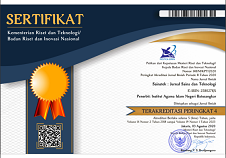SPINACH (Amaranthus tricolor L.) GROWTH USING ORGANIC FERTILIZER FROM Trichoderma harzianum DECOMPOSITION RESULT
Abstract
Long term period of using fertilizers is not beneficial for soil fertility due to decreasing soil organic matter content. Otherwise, the source of organic matter widely available as waste in the environment are not used optimally because the naturally decomposition quite long time. This problem can be overcome by utilizing various types of microbes, such as Trichoderma. This research conducted to determine the effect of organic fertilizer from the decomposition result of T. harzianum in enhancing growth of spinach plant. This study used a completely randomized design (CRD) with 6 treatments and 4 replications. The treatments were doses variation of decomposition of organic material; 0 g, 15 g, 30 g, 45 g, 60 g and 75 g. Data were analyzed with ANOVA and continued with Duncan New Multiple Range Test (DNMRT). The results showed that the application doses of organic fertilizer from decomposition result influences height, number of leaves, leaf area, fresh weight and dry weight of spinach plants. Optimal dose for all growth is 45 grams/polybag.
Keywords
Full Text:
PDF (Bahasa Indonesia)References
Affandi, M., Ni’matuzahroh and A. Supriyanto. (2001). Diversity and Visualization Character Fungi Associated with Degradation Process Litter in Mangrove Environmental. Medika Ekstra. 2 (1) : 39-52
Atmojo,S.W. (2003).Role of Organic Matter and Soil Fertility Efforts Against Their Management. Inauguration Speech of Professor in Sciences Soil Fertility. Universitas Sebelas Maret. Surakarta
Betham,Y.H.,H.Bustaman,A.D.Nusantara,E.Inoriah dan Riwandi. (1996). The ability Gliocladium, Trichoderma in Mereput Paceilomyces and Upland Rice Straw. OPF Project Report. Bengkulu: Universitas Bengkulu.
Doni,F., I. Anizan, C.M.Z. Che Radziah, A. H. Salman, M. H. Rodzihan and W. M. W. Yusoff. (2014). Enhancement of Rice Seed Germination and Vigour by Trichoderma spp. Res. J. App. Sci. Eng. Technol., 7(21): 4547-4552
Diaz, L.F., M. de Bertoldi and W. Bidlingmaier. Compost Science and Technology. Elsevier. Tokyo (2007).
Fisher, N.M. dan Goldsworthy. Cultivation Crop Physiologi of Tropical. (1985). Gajah Mada University Press. Yogyakarta
Gardner, F. P., R. B, Pearce dan R. L. Mitchell. (2008). Physiology of Cultivation crop. (Terjemahan: Susilo). Universitas Indonesia Press. Jakarta
Handayani, S.H., A. Yunus dan A. Susilowati. (2015). Liquid Organic Fertilizer Quality Testing of Various Local Microorganisms (Mol). EL-VIVO Vol.3, No.1:54–60. http:// jurnal.pasca.uns.ac.id.
Jalil, A.A.K. (2004). Microbial Enzyme and Material Selloluse Decomposision. Enzim Mikroba dan Bahan Penguraian Berselulosa. Biology Department. Jakarta
Jumin, H.B. (2002). Basic of Agronomy. Rajawali. Jakarta
Junialdi, R. (2013). Effect of Bokashi (Ageratum conyzoides L.) on Growth and quality of tomatoe nutrient (Lycopersicum esculentum Mill.). Thesis. Universitas Negeri Padang. Padang
Kasli. (2008). Fertilizer Biological Results Decomposers Some Organic Waste with Their Decomposer. Jerami vol 1 No. 3.
Lakitan, B. (1996). Growth Physiology and Plants Development. PT Raja Grafindo Persada. Jakarta
Lingga, P dan Marsono. (2001). Guidence of Fertilizer use. Penebar Swadaya. Jakarta
Mungara, E., Indradewa, D., dan Rogomulyo, R. (2013). Growth analysis and rice yield (Oryza sativa) in Conventional Farm system, Organic transision and Organic. Vegetalika Vol.2 No.3. p. 18-20
Nugroho, D.S. (2011). Study of organic fertilizer water hyacinth on Growth and Yield of white Amaranth and red amaranth. Thesis. Universitas Sebelas Maret. Surakarta
Nurahmi, E., Susanna dan R. Sriwati. (2012). Effect of Trichoderma on Seed Germination and Growth of Cocoa, tomatoes, and soybeans. Floratek 7 (1) : 57 – 65
Steel, R.G.D. & Torrie, J.H. (1991).Principles and Procedures of Statistics: An Approach Biometrics (Translate by: Bambang Sumantri). Jakarta: PT. Gramedia
Stevenson, F.T. (1982). (1982). Humus Chemistry. John Wiley and Sons, New York
Sudarmi. (2003).Importance of Micro Nutrient For Crop Growth. Widyatama.Vol. 22.No. 22:178-183
Permentan. (2006). no.2/Pert/HK.060/2/2006 about Organic Fertilizer and Soil restoration
Prasetya,B., S. Kurniawan, dan M. Febrianingsih. (2009). Effect of Dose and Frequency of Fertilizer Against N Uptake and Sawi Growth (Brassica juncea.L.) Pada Entisol. AGRITEK VOL. 17 NO. 5
Ratna, D.I. (2002).Effect of Biological Fertilizer Concentration Combination with Organic Liquid Fertilizer on the Quality and Quantity of Crop Tea (Camellia sinensis.L.) gambung clone 4. Ilmu Pertanian.10 (2): 17-25
Saba, H., Vibhash, D., Manisha, M., Prashant, K.S., Farham, H. & Tauseff, A. (2012).Trichoderma A Promising Plant Growth Stimulator and Biocontrol Agent. Mycosphere 3(4):524-531. http://www.mycosphere.org/pdf/ MC3_4 _No14. Pdf
Saravanakumar, K., Shanmuga Arasu, V. & Kathiresan,K. (2013). Effect of Trichoderma on soil phosphate solubilization and growth improvement of Avicennia marina. Aquatic Botany 104: 101-105
Sugito, Y., Y.Nuraini dan E. Nihayati. (1995). Organic Farming System. Faperta Unibraw. Malang
Suriadikarta, D.A. dan R.D.M. Simangkulangit. (2006). Organic fertilizer and Bio fertilizer (Ed.Simanungkalit dkk). Center for Agricultural Land Resources. Agency for Agricultural Research and Development
Suryanti, T. Martoedjo, A. H. Tjokrosoedarmono, dan E. Sulistyaningsih. (2003). Wine Red Root Disease Control with Trichoderma spp. Proc. National Congress XVII and National Seminar FPI, Bandung, 6-8 Agustus
Terry, N. (1970). Developmental physiology of sugar-beet. II. Effect of temperature and nitrogen supply on the growth, soluble carbohydrate content and nitrogen content of leaves and roots. Journal of Experimental Botany 21, 477-496
USDA. (2016). Full Report (All Nutrients) 11003, Amaranth Leaves, Raw. https:// ndb. nal. usda.gov.
Wahyudi. A (2010).`Practical Guide to Planting Vegetables. Agromedia Pustaka. Jakarta
Zhang, J. (1996). Interactive Effects of Soil Nutrients, Moisture and Sand Burial on the Development, Physiology, Biomass and Fitness of Cakile edentula. Annals of Botany 78: 591-598, http:// aob.oxfordjournals.org /content/78/5/ 591 .full.pdf
DOI: http://dx.doi.org/10.31958/js.v9i2.1034
Refbacks
- There are currently no refbacks.
Copyright (c) 2017 Azwir Anhar

This work is licensed under a Creative Commons Attribution-NonCommercial-NoDerivatives 4.0 International License.
Indexed by:
__________________________________________________________________________
Sainstek: Jurnal Sains dan Teknologi
ISSN 2085-8019 (print) | 2580-278x (online)
Published by Institut Agama Islam Negeri Batusangkar
Email: sainstek@iainbatusangkar.ac.id
This work is licensed under a Creative Commons Attribution-NonCommercial-NoDerivatives 4.0 International License.















